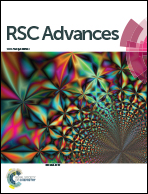A comparative study of optical nonlinearities of trans-A2B-corroles in solution and in aggregated state†
Abstract
A series of novel A3-corrole and trans-A2B-corroles have been synthesized with the aim of developing organic materials with improved nonlinear optical (NLO) properties. All three newly synthesized corroles have been characterized by various spectroscopic techniques including single crystal X-ray structural analysis of the representative one. The crystal structure analysis of 10-(4-hydroxyphenyl)-5,15-bis(2-bromo-5-fluorophenyl) corrole shows several O–H⋯N interactions. The self aggregates of all three corroles were prepared on a silicon wafer as well as on a quartz substrate by using a drop-casting method in a dichloromethane and methanol (1 : 2) solvent mixture. In all three free base corroles, well defined and nicely organized three-dimensional objects with diameter of ca. 320 nm (nanospheres), 450 nm (nanobulbs), and 120 nm (nanodiscs) were obtained. The NLO properties (nonlinear refractive index, n2 and two-photon absorption coefficient, β) of all of the corrole derivatives in toluene solution and in aggregated form were measured by the Z-scan technique. The nonlinear refractive indices, n2 of the free base corroles (in toluene solution) were found out to be −16.8 × 10−18 m2 W−1, −7.8 × 10−18 m2 W−1 and −25.9 × 10−18 m2 W−1 respectively and for the corresponding aggregates (nanoparticles of the free base corroles), it was found out to be −1.1 × 10−15 m2 W−1, −1.9 × 10−15 m2 W−1, and 71.8 × 10−15 m2 W−1 respectively. Similarly, the two-photon absorption coefficient, β of all the synthesized free base corroles (in toluene solution) were found out to be 5.7 × 10−15 m W−1, 1.9 × 10−15 m W−1 and 17.2 × 10−15 m W−1 respectively and for the corresponding aggregates (nanoparticles), the values were 4.0 × 10−13 m W−1, 2.0 × 10−13 m W−1, and 444.0 × 10−13 m W−1 respectively. These NLO properties of the free base corrole derivatives (in solution and in aggregates) have been explored with a specific aim to identify the possibility of their applications in ultrafast switching devices for use in high-speed fiber-optic communications and photonic integrated circuits.


 Please wait while we load your content...
Please wait while we load your content...